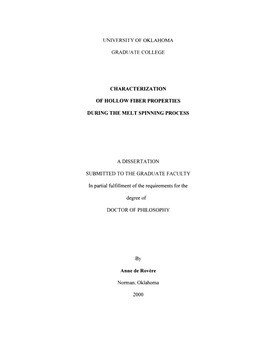| dc.contributor.advisor | Shambaugh, Robert L., | en_US |
| dc.contributor.author | De Rovere, Anne. | en_US |
| dc.date.accessioned | 2013-08-16T12:20:06Z | |
| dc.date.available | 2013-08-16T12:20:06Z | |
| dc.date.issued | 2000 | en_US |
| dc.identifier.uri | https://hdl.handle.net/11244/1020 | |
| dc.description.abstract | Substitution of hollow fibers for solid fibers would not only preserve the web properties (opacity and compression), but would actually improve the strength of each fiber. Hence, hollow fibers could be substituted for solid fibers in nonwoven webs. The final web would be lighter and cheaper that the same web made of solid fibers. | en_US |
| dc.description.abstract | Polypropylene hollow fibers were produced via the spunbonding process. Nitrogen gas was used as the lumen fluid. Individual fiber properties were tested, and web properties were also examined. In terms of compression-recovery and opacity, mats of hollow fibers are nearly identical to mats of solid fibers of the same outside diameter. In terms of individual fiber orientation, crystallinity, and strength, hollow fibers usually exhibit improved properties. On-line measurements showed that lumen fluid rate improves hollow fiber properties (orientation). Increased quenching rate may cause this difference. The fiber formation process was modeled with momentum, energy, and two continuity equations (one for the polymer, and one for the lumen fluid). The equations were solved numerically, and the results were compared to the on-line diameter data. Both Newtonian and viscoelastic constitutive equations were considered. The Newtonian model provided excellent fits to experimental outer diameters. Both experimental and predicted results show faster quenching, and thus higher orientation, on fibers processed using high nitrogen rates. | en_US |
| dc.format.extent | xiii, 254 leaves : | en_US |
| dc.subject | Engineering, Chemical. | en_US |
| dc.subject | Melt spinning. | en_US |
| dc.subject | Polymers. | en_US |
| dc.subject | Polypropylene fibers. | en_US |
| dc.title | Characterization of hollow fiber properties during the melt spinning process. | en_US |
| dc.type | Thesis | en_US |
| dc.thesis.degree | Ph.D. | en_US |
| dc.thesis.degreeDiscipline | School of Chemical, Biological and Materials Engineering | en_US |
| dc.note | Adviser: Robert L. Shambaugh. | en_US |
| dc.note | Source: Dissertation Abstracts International, Volume: 67-03, Section: B, page: 1559. | en_US |
| ou.identifier | (UMI)AAI3209250 | en_US |
| ou.group | College of Engineering::School of Chemical, Biological and Materials Engineering | |
